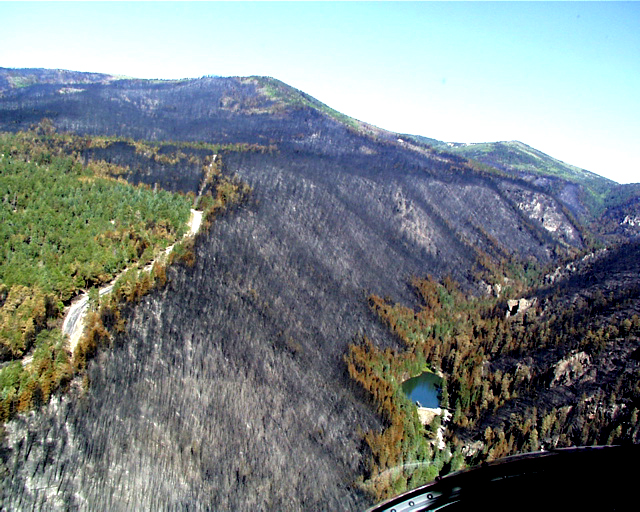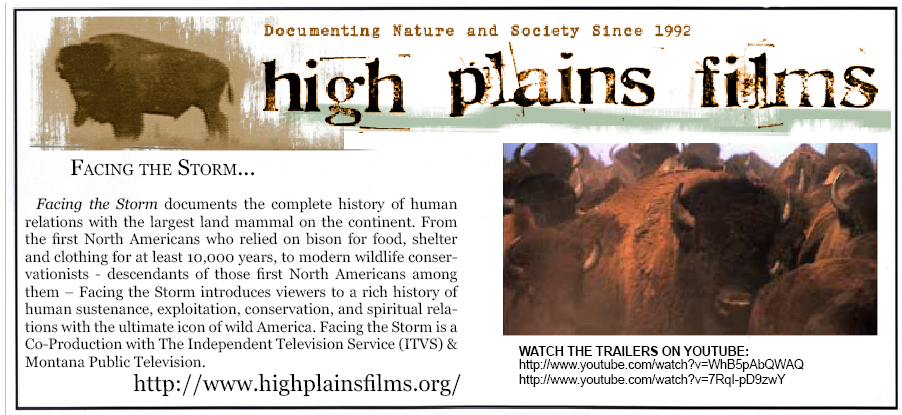Drought, Climate Change & Sick Forests Fuel Super Fires
The Summer of 2011 in the American Southwest…..Surrealistic & Devastating
By Kathleene Parker
EDITOR’S NOTE: Kathleene Parker’s story reflects burn damage as of July 8. Subsequent fire damage will no doubt boost the amount of acreage affected.
This summer has been surrealistic and traumatic in the Southwest.
As I write this, wildfire burns—and grabs headlines worldwide as it threatens a nuclear-weapons facility—immediately to the north of my home in Albuquerque, with Los Alamos in full evacuation and the pyrotechnic plume of the gigantic Las Conchas Fire a ghastly and looming presence visible for miles around.
It is the second “super fire” to hit the Atomic City in recent years, increasing in increments of tens of thousands of acres per day. Amazingly, it blew to unfathomable acreages almost immediately, clearly carpeting many miles of the Jemez Mountains and quickly rivaling and then surpassing its immediate “super fire” predecessor, the massive Cerro Grande of May 2000.
Another smaller fire smolders just north of Santa Fe, its plume also part of our lives in recent days, and that without the smoke billowing into the state from Arizona’s monstrous Wallow Fire.
Preoccupied with a busy schedule recently, I rushed outside one “evening” to do end-of-day chores, only to realize that it wasn’t evening; it was afternoon! Yet, automatic porch lights were on and twilight prevailed, except—I realized—for the vague, dark-red glow of the sun. Nights were even stranger, with what could be thick London fog obliterating streetlights and nearby houses from view. Only it wasn’t fog; it was smoke from distant Arizona!
Eventually even the national news media began to grasp, at least vaguely, the magnitude of events in forests that some have compared to “forests of gasoline.” Yet, there still seems little acknowledgement of the larger systemic issues that might underlie recent events, including decades of timber mismanagement.
And, there’s the even larger issue of drought and its two possibilities: one grim, one grimmer. The first is that the Southwest might be returning to far drier norms; the other, about which researchers have long tried to warn, that the Southwest would be hit first, worst and hardest by global warming.
Some early and troubling computer simulations done at Los Alamos National Laboratory, for example, show the possibility of the Mexico’s Chihuahuan Desert expanding north to Santa Fe and perhaps to southern Colorado this century! And, there is concern among researchers that the troubled forests might burn so hotly, so unnaturally and catastrophically, that, combined with climate change or drought, they will not regenerate; essential tree seeds would be destroyed and the soil harmed by high temperatures. Whole new ecosystems might replace the Montane ecosystems that managed to cling to existence at higher elevations since the last ice age to provide welcome sanctuary from desert heat and to provide a place for plant and animal diversity —growing on what some call the “Islands in the Sky.”
These “islands” include New Mexico’s Jemez, Gila and Sacramento mountains, Utah’s La Sal and Abajo (Blue) mountains and Arizona’s San Francisco Peaks, all looming thousands of feet higher than the surrounding desert. But, if the region warms and dries, the coolness and greenness will move ever-higher, perhaps to eventually be pinched off and disappear at the mountain tops.
As to “forests of gasoline,” the irony has not escaped me that when my ancestors arrived in New Mexico 122 years ago on what is today Chama’s Cumbress and Toltec Scenic Railroad, their cattle were at the back of the train in cattle cars. Few reporters have written as widely on the region’s timber crisis or its link to wildfire. Fewer still had ancestors who participated in beginning the problem! Those ancestors died unwittingly, since they were people who believed in conservation and stewardship of the land. But participate they did, including in Colorado’s San Juan Mountains, later hit by the 2002 Missionary Ridge Fire. More on that in a bit.
Researchers began to realize there was a forest problem in 1977. That spring, in drought, a wildfire—at 15,700 acres, the largest in New Mexico history at the time—exploded at Bandelier National Monument near Los Alamos, killing a firefighter and catching the attention of researchers and wildlands firefighters for its size and intensity. It signaled something profoundly amiss in the Southwest’s mid-elevation ponderosa pine forests, where sparse timber densities—on average only 60-to-80 mostly large, fire-resistant trees per acre—historically hosted only slow-burning ground fires, so low in intensity as to be insignificant, yet essential to forest health. Blowups were almost unheard of.
The La Mesa fire launched an era of research by foresters and others, including Los Alamos National Laboratory; the region’s universities, especially in Arizona; and the U.S. Geological Survey, especially at Bandelier National Monument and the surrounding Jemez Mountains.
By the 1990s, with reams of data gathered and analyzed—including photographic records showing how the forests looked a century earlier—experts warned that a new era of “super fires” was about to dawn in the Southwest. Large fires—like that at Yellowstone in the 1970s—are normal in the Northwest or in high, elevation conifer and mixed conifer, but had been rare in the Southwest mid-elevation ponderosa and lower elevation pinyon and juniper forests.
The problem began with 1880s livestock overgrazing, which stripped away the grasses and shrubs essential to fuel the small fires that historically moved along the ground burning forest-floor rubble and small trees.
If allowed to live, such trees cause too-heavy timber densities and represent “ladder fuels,” that carry fire from the ground up into the forest canopy. In the past, fire burned safely around tall, mature trees, with heavy, highly fire-resistant bark and branches far above the flames. The ladder fuels—the small-to-mid-sized trees in today’s tree-choked forests—carry flames from the ground, up into their own branches, and then into those of larger trees above, resulting in catastrophic—and sometimes deadly—crown fires and massive blowups. Blowups like that at Los Alamos, which, beginning Sunday, June 26, created a pyrotechnic plume that caused Albuquerque residents to gape at what looked a lot like a volcano exploding on the northern horizon. Blowups have unfortunately grown more common than thunderstorms in the Southwest in the current drought.
Cattle grazing is where the problem began, clearly evident in pollen and other studies that show dramatic shifts in vegetation types and densities coinciding with the arrival of the railroads—and large numbers of cattle and sheep—in the Southwest.
Later, thirty years or more, came concerted fire suppression. The fires that ignited were quickly extinguished by increasingly efficient wildlands firefighters. It was a war against fire, viewed by land managers of the day as evil and destructive—which it increasingly was in the region’s sickening forests—but the answer should not have been an end to fire, but more fire.
That was followed by harvesting practices that favored huge fire-resistant trees—ponderosa pine of 15 and 20 feet in circumference were not uncommon before logging—and ignored millions of young trees that, when Nature was in charge, couldn’t proliferate. Before the logging, a wet “pulse” year might cause thousands of seeds to sprout, but these, in a year or a few, would be removed by ground fire. At best, only a few humble interlopers would survive. The problem was only compounded by the construction of roads that blocked fire from moving through the forest.
Today’s tree-choked forests bear little resemblance to those when my great-grandparents arrived in New Mexico. Ponderosa pine forests of the 1880s were mostly open meadow-like savannahs, not the tree-choked reality that today pervades in mid-elevation areas of the region.
I experienced this first hand in the mid-1990s, as I was first beginning to report about fears that the Southwest’s forests were entering dangerous new times. I returned to areas I knew as a child at Vallecito Lake east of Durango, Colorado, and was shocked by the transition in just decades. A meadow where my friends and I had played as children, by the 1990s, was becoming dense forest, dominated by small and medium-sized trees growing under the old, familiar towering giants. That meadow and that forest, incidentally, burned in the massive Missionary Ridge Fire of 2002.
And that was what concerned researchers: That a new era of super fires—like none we had ever experienced—is dawning. But this is only part of a perfect storm which might be converging on the region.
Climatologists, as drought hit during the winter of 1995-1996, pointed out that 1950 to 1995, despite the “fifties drought,” were the wettest in the Southwest in roughly 2,000 years!
Despite trees dying by the millions, huge forest fires and even the high country turned brown at mid-summer by a lack of rain, climatologists remind us that 2000 and 2002 were average precipitation years compared with the real droughts, such as that which triggered the exodus of the Anasazi between 1200 and 1300, not to mention the absolutely catastrophic drought between 300 and 500 A.D.!
Because it was all most of us ever knew, we assumed that post-1950 moisture was the norm. Thus, a return to what the Southwest historically has been, not to mention a Southwest perhaps made even worse by global warming, in combination with huge timber densities, experts warned, would indicate a high probability of super fires.
The super fire era began at Los Alamos in early May 2000 when a match struck to grass on Cerro Grande Peak for a prescribed burn quickly escaped and—driven by unexpected winds—hit timber long ripe for disaster. First, Cerro Grande took one long, shockingly high-speed, high-intensity run through miles of heavy, thick timber; then it teetered at the edge of the Atomic City for 3 days, before moving through town during a major wind event. It burned hundreds of structures in the town proper and scorched the nation’s premier nuclear weapons lab, where vast stores of nuclear and chemical materials are kept. Townspeople fled in a massive evacuation, even as a fire—that some said sounded like helicopters hovering near—moved into town. The fire eventually grew to 43,000 acres, three times the size of the “huge” La Mesa Fire.
Cerro Grande was nicknamed the “Millennium Fire,” because it was the first big fire of the millennium and because it was the first of the long-prophesized super fires. Of note, it grew to its spectacular 47,000-plus acres in several days, but as of this writing the Las Conchas, barely 48-hours old, already exceeds 100,000 acres and is still growing!
And, Cerro Grande has been dwarfed by other subsequent fires:
* The Missionary Ridge Fire, in 2002, in the San Juan Mountains east of Durango, Colorado burned 73,145 acres and spawned fire tornadoes—in the dry lake bed at Vallecito Reservoir—so powerful that they tossed cars, boats and RVs parked there for safety against the fire about like toys.
* The Hayman Fire, in Colorado, in 2002 burned 138,114 acres.
* The Rodeo-Chediski Fire, actually the merging of two fires in Arizona burned 468,638 acres.
* This year’s Wallow Fire, so far at an estimated half-million acres and likely to smolder until winter snows extinguish the last ember.
* And, the Las Conchas—still a new monster loose in the forest—its size and destiny still to be determined.
Perhaps it is time for us—particularly our leaders—to acknowledge that the Southwest of the future might not be as hospitable as that which we have known. Perhaps it is time to ask just how much more evidence we need before we at least discuss the possibility that the current drought and associated super fires might be linked to a global warming phenomenon that requires us to do more than pretend global warming isn’t happening!
Kathleene Parker, of Rio Rancho, New Mexico, lived in Los Alamos for 13 years, where she was a correspondent for the SANTA FE NEW MEXICAN, covering Los Alamos, Los Alamos National Laboratory and timber and fire issues throughout northern New Mexico. She authored a feature on the Cerro Grande Fire for FOREST MAGAZINE in May 2000.)
To view this article as a PDF, click here: aug11-16-17
and here: aug11-18-19
Don’t forget the Zephyr Ads! All links are hot!







What was the point of mentioning global warming at the end of the article? The problems started 122 years ago. Let’s fix the old problems before we worry about problems that might start in 50 years.